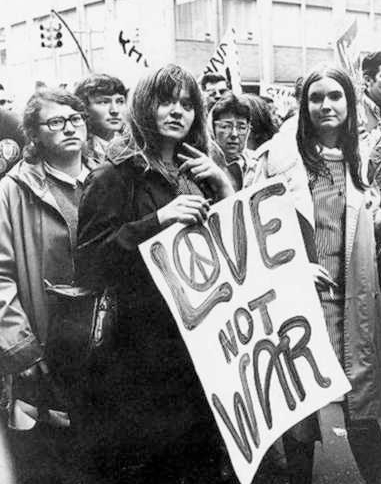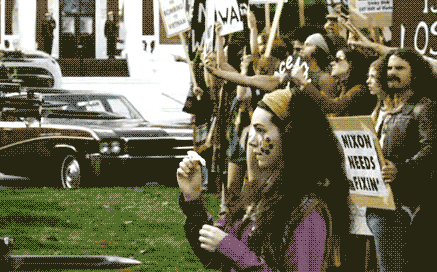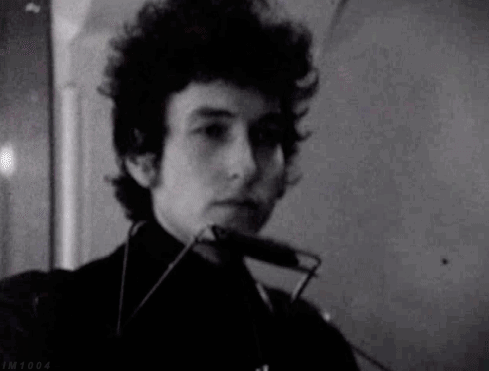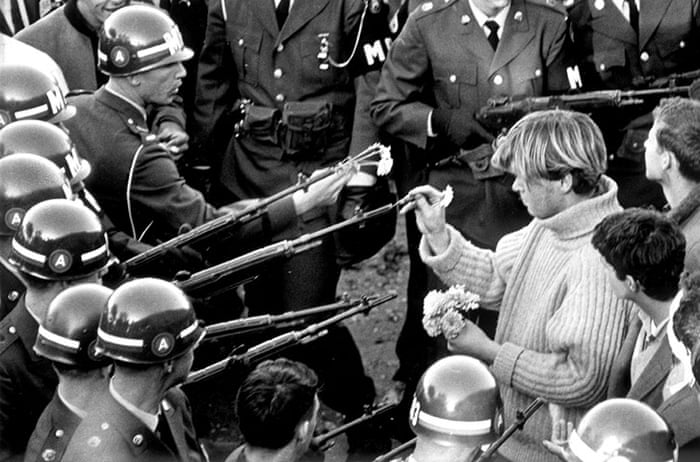 The style of photograph "Flower in the Gun" displays the mismatch between military officials and war protesters during the 1960s. An important element to analyze is the angle of the photograph. The angle displays an overwhelming presence of soldiers compared to one lone female protester. Soldiers, armed with bayonets, extend in a straight line all the way throughout the photograph. In comparison to the large number of soldiers, the photograph shows a single protester. The photograph displays a distinct difference in numbers between the military and protesters. Protesters are at a clear disadvantage to promote peace. Another element for style is hue. The soldiers are wearing black uniforms and holding black rifles, in contrast the female protester is wearing colorful clothing and holding a flower. War protesters in the 1960s used colorful clothing to symbolize peace and serenity of the movement. Vibrant colors for everyday items like clothing were based off of the colors of flowers. While the colors of protesters represented peace, the colors of the soldiers represent death and despair. Death is an obvious mismatch to peace. Combining angle and hue, death overwhelms peace in the photograph. Through elements of the photograph there is a clear mismatch of ideals and symbolism between protesters and military personal.
The style of photograph "Flower in the Gun" displays the mismatch between military officials and war protesters during the 1960s. An important element to analyze is the angle of the photograph. The angle displays an overwhelming presence of soldiers compared to one lone female protester. Soldiers, armed with bayonets, extend in a straight line all the way throughout the photograph. In comparison to the large number of soldiers, the photograph shows a single protester. The photograph displays a distinct difference in numbers between the military and protesters. Protesters are at a clear disadvantage to promote peace. Another element for style is hue. The soldiers are wearing black uniforms and holding black rifles, in contrast the female protester is wearing colorful clothing and holding a flower. War protesters in the 1960s used colorful clothing to symbolize peace and serenity of the movement. Vibrant colors for everyday items like clothing were based off of the colors of flowers. While the colors of protesters represented peace, the colors of the soldiers represent death and despair. Death is an obvious mismatch to peace. Combining angle and hue, death overwhelms peace in the photograph. Through elements of the photograph there is a clear mismatch of ideals and symbolism between protesters and military personal.Monday, October 6, 2014
Style of "Flower in the Gun"
 The style of photograph "Flower in the Gun" displays the mismatch between military officials and war protesters during the 1960s. An important element to analyze is the angle of the photograph. The angle displays an overwhelming presence of soldiers compared to one lone female protester. Soldiers, armed with bayonets, extend in a straight line all the way throughout the photograph. In comparison to the large number of soldiers, the photograph shows a single protester. The photograph displays a distinct difference in numbers between the military and protesters. Protesters are at a clear disadvantage to promote peace. Another element for style is hue. The soldiers are wearing black uniforms and holding black rifles, in contrast the female protester is wearing colorful clothing and holding a flower. War protesters in the 1960s used colorful clothing to symbolize peace and serenity of the movement. Vibrant colors for everyday items like clothing were based off of the colors of flowers. While the colors of protesters represented peace, the colors of the soldiers represent death and despair. Death is an obvious mismatch to peace. Combining angle and hue, death overwhelms peace in the photograph. Through elements of the photograph there is a clear mismatch of ideals and symbolism between protesters and military personal.
The style of photograph "Flower in the Gun" displays the mismatch between military officials and war protesters during the 1960s. An important element to analyze is the angle of the photograph. The angle displays an overwhelming presence of soldiers compared to one lone female protester. Soldiers, armed with bayonets, extend in a straight line all the way throughout the photograph. In comparison to the large number of soldiers, the photograph shows a single protester. The photograph displays a distinct difference in numbers between the military and protesters. Protesters are at a clear disadvantage to promote peace. Another element for style is hue. The soldiers are wearing black uniforms and holding black rifles, in contrast the female protester is wearing colorful clothing and holding a flower. War protesters in the 1960s used colorful clothing to symbolize peace and serenity of the movement. Vibrant colors for everyday items like clothing were based off of the colors of flowers. While the colors of protesters represented peace, the colors of the soldiers represent death and despair. Death is an obvious mismatch to peace. Combining angle and hue, death overwhelms peace in the photograph. Through elements of the photograph there is a clear mismatch of ideals and symbolism between protesters and military personal.Establishing Ethos for "Flower in the Gun"
The photographer, Marc Riboud, has a long history in journalism. He has many experiences photographing all over the world. He traveled through both North and South Vietnam. The photograph he takes is published in many publications worldwide. His vast wealth of experience and international appeal give him extrinsic ethos. He is trusted to be a honest photographer. He is trusted to not stage the photograph. This trust makes the image seem more genuine and real. The only problem the photograph has with establishing ethos is that it only shows one view. It could have been framed to promote the photographer's bias. The photograph shows only one of the many protestors and a line of soldiers. This unfair view of the soldiers hurts the general public's respect for the photographer and hinders its effect outside of antiwar protestors.
Sunday, October 5, 2014
Logos of "Masters of War"
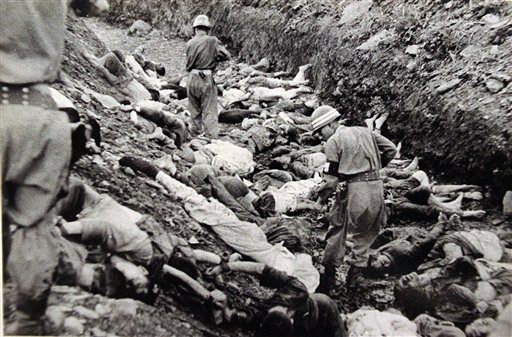 As stated in our post about the ethos of
“Masters of War,” people knew Bob Dylan as a rebellious soul. Unsurprisingly,
in “Masters of War” he went against “the man” and criticized America’s
involvement in Vietnam. With Dylan’s reputation as a protestor in mind, one can
clearly identify his logical argument of the song. Dylan argued that the
politicians, the “masters,” responsible for the fighting in Vietnam caused
great amounts violence and death, unaware and apathetic to the true effects of
their actions. He supports his belief of the masters’ indifference through the
lyrics, “You fasten the triggers for the others to fire. Then you set back and
watch when the death count gets higher. You hide in your mansion as young
people’s blood, flows out of their bodies and is buried in mud.” These words
show that the politicians did not care about the rising death toll in Vietnam; as
long as they could hide from the violence, they were content. He also asserts
his belief that the government officials did not care about the lives of the
soldiers through the lyrics, “You play with my world like it’s your little toy.”
The comparison of Bob’s life to a toy demonstrates how the politicians did not
take their actions seriously. In addition, Bob Dylan strengthens his argument
further by appealing to logos through the use of allusions. For example, he
states, “But there’s one thing I know, though I’m younger than you. Even Jesus would never forgive what you do.”
As stated in our post about the ethos of
“Masters of War,” people knew Bob Dylan as a rebellious soul. Unsurprisingly,
in “Masters of War” he went against “the man” and criticized America’s
involvement in Vietnam. With Dylan’s reputation as a protestor in mind, one can
clearly identify his logical argument of the song. Dylan argued that the
politicians, the “masters,” responsible for the fighting in Vietnam caused
great amounts violence and death, unaware and apathetic to the true effects of
their actions. He supports his belief of the masters’ indifference through the
lyrics, “You fasten the triggers for the others to fire. Then you set back and
watch when the death count gets higher. You hide in your mansion as young
people’s blood, flows out of their bodies and is buried in mud.” These words
show that the politicians did not care about the rising death toll in Vietnam; as
long as they could hide from the violence, they were content. He also asserts
his belief that the government officials did not care about the lives of the
soldiers through the lyrics, “You play with my world like it’s your little toy.”
The comparison of Bob’s life to a toy demonstrates how the politicians did not
take their actions seriously. In addition, Bob Dylan strengthens his argument
further by appealing to logos through the use of allusions. For example, he
states, “But there’s one thing I know, though I’m younger than you. Even Jesus would never forgive what you do.”  By inserting this widely historical/religious figure, Dylan makes use of an
assumption that almost everyone understands. Therefore, the audience can use
previous knowledge about Jesus to make the conclusion that the actions of the
masters of war were so heinous that even the One known for loving all people could never
forgive the politicians’ deeds. Although Dylan makes a stronger appeal to
pathos in his song, “Masters of War” has elements of logos that help the
audience form an opinion, perhaps one similar to that of the writer’s.
By inserting this widely historical/religious figure, Dylan makes use of an
assumption that almost everyone understands. Therefore, the audience can use
previous knowledge about Jesus to make the conclusion that the actions of the
masters of war were so heinous that even the One known for loving all people could never
forgive the politicians’ deeds. Although Dylan makes a stronger appeal to
pathos in his song, “Masters of War” has elements of logos that help the
audience form an opinion, perhaps one similar to that of the writer’s.
Saturday, October 4, 2014
Style of Masters of War
In the live version of “Masters of War”, Bob Dylan usually
starts out with a guitar intro and talks to the audience. He tells them how “some
people see this song…as very naive” but he doesn't care because he hopes that
the real-life masters of war die. The fact that he takes the time to address
his position and defend his beliefs from any critics is significant because it
shows how Dylan was determined to spread his message no matter what people
thought of the song. He contrasts the violence and horror of the lyrics with the peaceful quality of his voice. Only Dylan could sing about blood
running into the mud or watching the masters of war being lowered into their
graves and still keep up the folk music quality of the song. The contrast
between what he is saying and the calming effects of his voice and guitar
chords creates an interesting juxtaposition. It calls attention to the severe
contrast between violent words and peaceful music. There were critics that
argued that Dylan didn't have a powerful singing voice, but the lyrics more
than make up for what his vocal chords lack. Professionals have argued that
what Dylan says is more important than how he sounds, making him more of a poet than a musician. He left behind a lasting legacy of powerful words and opinions
that added to a movement determined to bring peace to the world.
Friday, October 3, 2014
Emotions and Flowers
The photograph of the flower in the gun relies on an emotional appeal to relay the message of peace. The innocence of the young women clashes with the seriousness of the soldiers. In the face of danger the women isn't afraid and offers peace. The women represents the anti-war movement as a whole within the picture. The angle of the photograph portrays one lone women against a large group of soldiers. The angle creates the sense that the soldiers are ganging up against one innocent women who is protesting peacefully.This mismatch between the women and soldiers shows the passion of the anti-war movement against the government. The contrast in colors within the photograph emphasizes the mismatch of the soldiers and the women. The soldiers are wearing all dark clothing and holding black rifles, whereas the women is wearing colorful clothing and holding a flower. Dark colors represent evil and bright colors represent good. Soldiers are made out as evil and the women is made out to be good. The photograph brings out the classic emotional battle between good and evil. The strong emotional response to the mismatch within the photograph created support for anti-war movement.
It's Simply Logical: the Logos in the Flower in the Gun
While the message the photographer was trying to get across was mostly emotional, there is still an appeal to reason. The photograph is framed to show more guards than protestors. This makes it so the police presence seems disproportionately large. The photographer is trying to assert that the government is overreacting to the peaceful protestors and trying to stifle the antiwar movement. It is not reasonable to point rifles at someone with a flower. He is trying to show that the soldiers and the war they represent are simply illogical and should be stopped.
Thursday, October 2, 2014
Bob Dylan's Appeal to Pathos
Throughout the 1960s, Bob Dylan had a reputation of being a rebellious soul, often objecting to
societal norms and governmental policies. He created this disobedient status
through the writing of multiple protest songs. In the lyrics of his music, Dylan wove in many pathetic appeals that
helped convince listeners to accept his point of view. Specifically, the piece “Masters
of War” has multiple uses of imagery, analogies, and concrete language that help
Bob Dylan make an appeal to the emotions of his audience.
 First, Bob
Dylan uses multiple images throughout the song to provide vivid scenes in the
mind of the listeners. For example, he sings, “You hide in your mansion, as
young people’s blood flows out of their bodies and is buried in the mud.” Here,
Dylan’s lyrics evoke the picture of a young man at war in Vietnam dying a gruesome
death while the people who sent him to war sit comfortably in their houses of
luxury. The image of the blood of the soldier flowing into the mud gives the
listeners an idea of the atrocities that happened in Vietnam. This idea prompted
Dylan’s audience to feel empathetic toward the soldiers, the victims, and
hostile toward the politicians, the villains.
First, Bob
Dylan uses multiple images throughout the song to provide vivid scenes in the
mind of the listeners. For example, he sings, “You hide in your mansion, as
young people’s blood flows out of their bodies and is buried in the mud.” Here,
Dylan’s lyrics evoke the picture of a young man at war in Vietnam dying a gruesome
death while the people who sent him to war sit comfortably in their houses of
luxury. The image of the blood of the soldier flowing into the mud gives the
listeners an idea of the atrocities that happened in Vietnam. This idea prompted
Dylan’s audience to feel empathetic toward the soldiers, the victims, and
hostile toward the politicians, the villains. Second, Dylan
placed analogies throughout “Masters of War,” that help convince the audience
to accept his viewpoint and protest the violence of the 1960s, particularly the
Vietnam War. Specifically, Bob sang, “Like Judas of old, you lie and deceive. A
world war can be won you want me to believe.” Dylan made his appeal to pathos by
traitor Judas. He wanted the listeners to
feel betrayed by the government, hopefully leading them to question why America
was in Vietnam.
Second, Dylan
placed analogies throughout “Masters of War,” that help convince the audience
to accept his viewpoint and protest the violence of the 1960s, particularly the
Vietnam War. Specifically, Bob sang, “Like Judas of old, you lie and deceive. A
world war can be won you want me to believe.” Dylan made his appeal to pathos by
traitor Judas. He wanted the listeners to
feel betrayed by the government, hopefully leading them to question why America
was in Vietnam.
Third, Bob
Dylan used concrete language to stir feelings of negativity and disgust within his
listeners. Take, for example, the lyrics, “You put a gun in my hand and you
hide from my eyes. And you turn and run farther, when the fast bullets fly.”
One can picture a young man, inexperienced and afraid, thrown into active combat
as the “masters of war” run away, not wanting to witness the damage that they
are causing. The language that Dylan used attempted to lead his listeners to
feel ashamed of the American leaders’ careless actions. He wanted his audience
to realize that the politicians were sending unskilled young men to an early
death.
Throughout “Masters
of War,” Bob Dylan used charged language in order to make his appeals
to
pathos. The lyrics of the song helped conjure feelings of empathy, distrust,
and anger within his audience, effectively making his pathetic appeal.
Ethos of "Masters of War"
Bob Dylan performing "Blowin' in the Wind"
Bob Dylan developed a large amount of extrinsic
ethos and became known as the voice of the 1960s Vietnam War protests. When
people went to hear him play, they expected songs promoting peace and
denouncing the death and horror that wars brought on soldiers, families, and children.
Though “Masters of War” was only on Bob Dylan’s second album, the incredibly
popular song “Blowin’ in the Wind” came out earlier and defined his period of
rebellion; it can be heard in the background of almost all 1960s documentaries.
This song created Bob Dylan, the protest singer, as he asked rhetorical
questions like “how many times must the cannon balls fly before they’re forever
banned?” and the answer, of course, is blowin’ in the wind. Within the lyrics
of “Masters of War” created a much different type of intrinsic ethos than “Blowin’ in the Wind” because instead of asking questions
about when the world would see
peace and equality, Dylan tells us that there is someone to blame for all the
destruction. They are the mysterious “masters of war” who hid behind desks in
offices and never saw the children crying or the soldiers dying. Dylan appealed
to a morally compelling argument asking if it was right for people to sit back and
collect money while their actions resulted in higher and higher death counts.
One thing Bob Dylan did not do is ethically consider alternative points of view
about war. Instead of appealing to neutral or conservative groups, he was very
liberal and antagonized anyone who didn’t share his opinion. Instead of using
his song to try to persuade politicians that war in Vietnam was wrong, he
personally attacked them by singing “I’ll watch while you’re lowered, down to
your deathbed, and I’ll stand over your grave, ‘til I’m sure that you’re dead”.
This doesn't leave any room for a compromise, Bob Dylan was angry at these
masters of war and had no interest in hearing their arguments for violence,
thus decreasing the amount of intrinsic ethos he developed in the lyrics.
Tuesday, September 30, 2014
Kairos of "Masters of War"
The 1960s in America
are characterized in history books by hippie culture, Vietnam War protests, and
overall social rebellion, when in reality this counterculture movement was made
up of the minority. Bob Dylan represented this minority through his powerful
and passionate folk songs, especially “Masters of War”. In this repetitive song
he called out the politicians and business men who stood to profit from war but
had never actually seen a battle firsthand. Rebels and hippies all over the
country choose Bob Dylan to be their idol as they publicly declared their
hatred of war through burning draft cards and putting flowers in the barrels of
guns at protests. Bob Dylan had always been a rebel in his own way, he dropped
out of college to move to New York City and become a musician. When he gained
recognition in a New York Times article, fans flocked to his music and his
messages to stop violence and promote peace. Bob Dylan’s messages of peace came
at a time when Americans were unsure if America should be involved in a war in
Vietnam. Dylan's political movement gained traction throughout the war, but “Masters of War”
was written in 1962-1963 and was one of the first songs people rallied behind
to protest the war. The kairos, translating to the timeliness, of this song was
perfect for its era because when people were unsure of how they felt about
another war, Bob Dylan criticized not only the war, but those who supported the
war for their own personal benefit. His lyrics were so powerful and influential that some compared him to a poet and argued that he deserved the Nobel Prize in Literature. “Masters of War” was the song that launched
Bob Dylan into the role as the original protest singer and he went on to define
a decade of protests and rebellion against “the man”.
Stasis Theory- Flower in the Gun
We define the photograph of the flowers in the gun as a protest strategy to promote peace. Backlash against the Vietnam War paved the way for anti-war protests in the United States. Protesters started putting flowers into the barrels of guns as a non-violent way to demonstrate in front of military personal and riot police. Flower in the gun was a new strategy and was coined by American beat writer Allen Ginsberg as "Flower Power". Flower power became a popular movement in the United States especially with the Hippies. Flower in the gun is a great example of a meaningful non-violent way of protest. Flowers represent love, peace and serenity, the main focuses of the anti-war movement. It presented the positives of the movement, while not acting in harmful ways. Flower power was implemented and ingratiated into the Hippie culture. Hippie clothing transformed into flowery vibrant colors to convey their message of peace and nature. The images of flowers contributed to the symbolism of the anti-war movement during the 1960s.
The Kairos Behind the Flower in the Gun
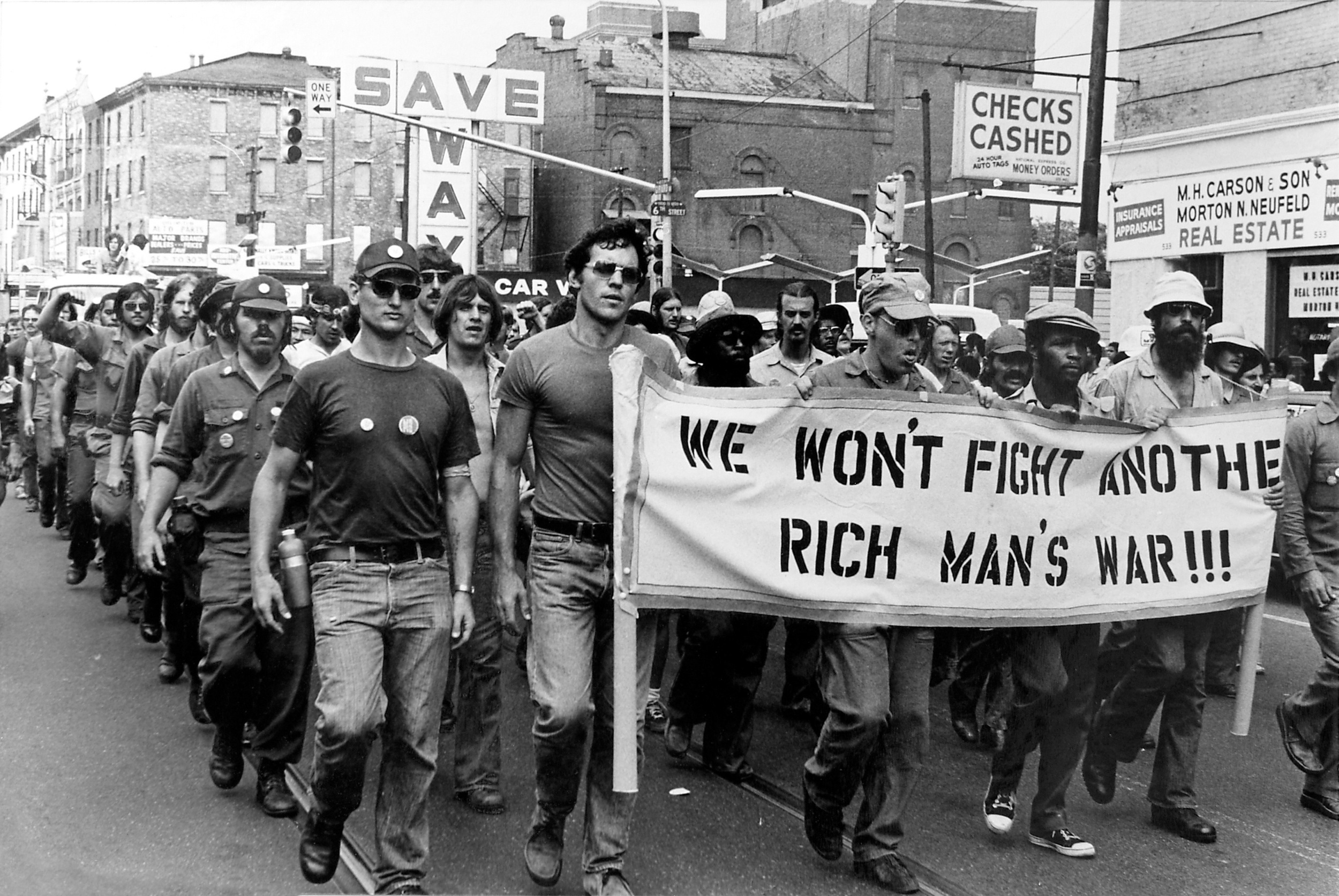 The 1960s were a turbulent time for America. There was a rise of counter cultures and the backlash from the main stream. One of the polarizing issues of the day was the Vietnam war. The Vietnam war caused a massive social divide between the disenfranchised youth and the so called "silent majority". Most Americans thought that the antiwar protestors were at best foolish, naive children and at worst traitors.The antiwar protestors were appalled by the loss of life in Vietnam and the senselessness of the conflict. Many felt that they were not being represented and went to the streets to protest. The photograph was taken at one of those protests. On October 21st 1967, thousands of antiwar protestors converged on the Pentagon. The photograph, taken by Marc Riboud, was a juxtaposition between the ideals of violence and peace. The stark contrast between the dangerous guns pointed at the woman's face and the harmless flower she is offering in return fit well in the time of turmoil. At the protest many were arrested and beaten by those guarding the Pentagon. The continued violence against unarmed protestors really helped elevate the images emotional effect. The government's overreaction to the protestors led many to sympathize with the protestors. The violence and strife of the 1960's helped accentuate the photograph's message of peace.
The 1960s were a turbulent time for America. There was a rise of counter cultures and the backlash from the main stream. One of the polarizing issues of the day was the Vietnam war. The Vietnam war caused a massive social divide between the disenfranchised youth and the so called "silent majority". Most Americans thought that the antiwar protestors were at best foolish, naive children and at worst traitors.The antiwar protestors were appalled by the loss of life in Vietnam and the senselessness of the conflict. Many felt that they were not being represented and went to the streets to protest. The photograph was taken at one of those protests. On October 21st 1967, thousands of antiwar protestors converged on the Pentagon. The photograph, taken by Marc Riboud, was a juxtaposition between the ideals of violence and peace. The stark contrast between the dangerous guns pointed at the woman's face and the harmless flower she is offering in return fit well in the time of turmoil. At the protest many were arrested and beaten by those guarding the Pentagon. The continued violence against unarmed protestors really helped elevate the images emotional effect. The government's overreaction to the protestors led many to sympathize with the protestors. The violence and strife of the 1960's helped accentuate the photograph's message of peace.
"Masters of War"- Analyzing Bob Dylan's Rhetorical Message
 “Masters of War,”
written by Bob Dylan in 1962-1963,
targeted the United States government regarding the Vietnam and Cold Wars. He chastised the leaders of the United
States for misleading the American citizens into believing that we, as a nation,
could actually win a world war. Additionally, Dylan called out the leaders in
Washington, claiming that they constantly pushed for war, as long as they did
not have to do the fighting. These politicians “hid behind their desks…
fastening the trigger, for others to fire” as they sent unsuspecting, young men
into combat.
“Masters of War,”
written by Bob Dylan in 1962-1963,
targeted the United States government regarding the Vietnam and Cold Wars. He chastised the leaders of the United
States for misleading the American citizens into believing that we, as a nation,
could actually win a world war. Additionally, Dylan called out the leaders in
Washington, claiming that they constantly pushed for war, as long as they did
not have to do the fighting. These politicians “hid behind their desks…
fastening the trigger, for others to fire” as they sent unsuspecting, young men
into combat.
When
reviewing history, it is obvious that both the Cold War and the Vietnam War
actually happened. The Cold War resulted from the tense relationship between
the US and USSR regarding communism, eventually leading to a competition in
multiple areas, including space travel and weapon build-up. The Cold War raged
on, from the end of World War II up until the fall of the Soviet Union, never
resulting in actual combat. On the other hand, the United States actually sent
soldiers to help the South Vietnam defeat the northern, Communist
Viet Minh party and southern Viet Cong regime. The conflict lasted from 1954 up until 1973, with more
than three million casualties, half of which were civilian deaths. The United
States became involved with the Vietnam War in an attempt to contain Communism
and prevent the Viet Minh from gaining control of the entire country.
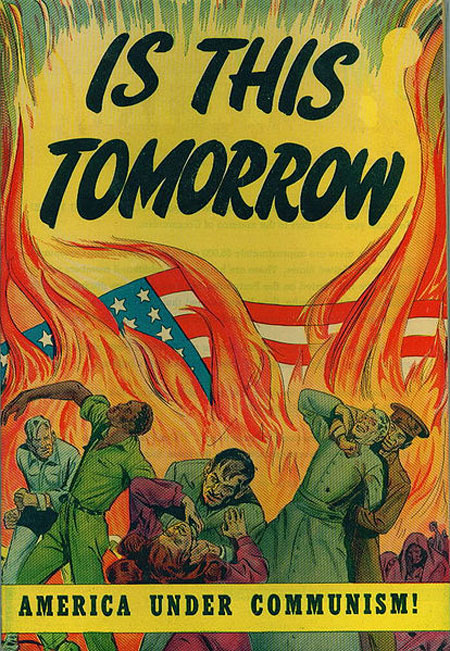 In accordance
with Dylan’s message, it seems that both the Cold War and Vietnam War did not
have any value nor did they improve the quality of life in the United States. In
fact, the Cold War led to the Red Scare,
which initiated a sense of anxiety throughout the country. Additionally, when
In accordance
with Dylan’s message, it seems that both the Cold War and Vietnam War did not
have any value nor did they improve the quality of life in the United States. In
fact, the Cold War led to the Red Scare,
which initiated a sense of anxiety throughout the country. Additionally, when
Subscribe to:
Posts (Atom)

